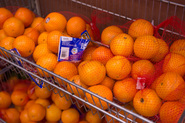 Guide Rate Update: Milk Consolidation & Juice Pilot
As of February 2017, FDPIR participants can choose from any combination of skim evaporated milk, instant nonfat dry milk, or 1% UHT milk up to eight units per person. This combines the two milk categories that currently exist.
We also recently began a pilot that allows participants to exchange some or all of the fruit juice currently offered in FDPIR for canned, dried, or fresh fruit. Eight Indian Tribal Organizations (ITOs) are participating in this pilot: Sherwood
Valley Food Program, Southern California Tribal Chairman’s Association (SCTCA),
Spirit Lake Sioux Tribe, Rosebud Sioux Tribe of South Dakota, Choctaw Nation of
Oklahoma, Chickasaw Nation, Menominee Indian Tribe of Wisconsin, and Sault Ste.
Marie Tribe of Chippewa Indians. USDA will review distribution patterns under the pilot to determine next steps.
|
FDPNE Grant: Request for Applications Released
USDA released the Fiscal Year 2017 Request for Applications
(RFA) for the Food Distribution Program Nutrition Education (FDPNE) Grant on March 1. The application due date is May 1. Since 2008, FDPNE has
made approximately $1 million available per year for FDPIR programs to apply
competitively for nutrition education grants. Examples of activities conducted
by grantees include nutrition education classes, cooking demonstrations, taste
testing of items available through FDPIR, gardening projects, and more. Visit the FDPIR
Nutrition Education Grant Awards website for additional information, and click here to view or download the FDPNE RFA from Grants.gov!
In November, USDA staff had the opportunity to visit Choctaw Nation in Oklahoma and attend one of the acclaimed "Cooking with Carmen" food demos! Carmen Robertson taught FDPIR clients how to use items from the food package, including beef roast and the new blue cornmeal, to make an easy and delicious tamale recipe.
 Easy Blue Cornmeal Tamales
1 beef roast*
1 large onion, diced*
2 TBSP fresh garlic
2 TSP crushed red pepper flakes
2 TBSP oil*
5 TBSP chili powder
Cornmeal (blue or yellow)*
*indicates a USDA Food
1. Cook roast in crock pot the night
before until tender.
2. Save juice from roast for cornmeal
mixture.
3. Sauté onions and garlic in oil
until tender.
4. Pull apart roast and add to pan of
onion mixture.
5. Mix cornmeal and juice from the
roast until mush consistency.
6. Spread cornmeal mix on a piece of
tin foil and spoon in meat mix.
7. Fold over and crimp edges of foil.
8. Drop packet in a large pan of
boiling water and let boil for 10 minutes.
9. Let cool and enjoy topped with
enchilada sauce or chili.
|
 Sharing Gallery: Salmon Webisodes and More!
Check out the latest videos on the Recipes & Cookbooks page of the FDPIR Sharing Gallery. We've recently added three "Store Outside Your Door" webisodes, showcasing traditional salmon fishing and preparation, from the Alaska Native Tribal Health Consortium, along with a Pressure Cooker Beef Stew recipe video from the Menominee Indian Tribe of Wisconsin.
Interested in contributing recipes or other resources to the Sharing Gallery? Email us at USDAFoods@fns.usda.gov.
|

NEW USDA Foods Webinar List
Are you interested in receiving announcements for upcoming USDA
Foods webinars? We have created a new email list via GovDelivery - the
same service we use to send out these e-letters - where you can sign up to
receive notifications about webinar dates, topics, and registration details.
Here’s how to sign up:
1. Click here!
2. Enter your email address and click Submit.
3. Scroll down to the Webinars category (click the + next to
Webinars to expand the list, if needed).
4. Check the boxes next to the topic(s) you’d like to sign up
for based on your program(s) of interest:
- Webinars
– Schools/Child Nutrition USDA Foods Programs
- Webinars
– CSFP
- Webinars
– TEFAP
- Webinars
– FDPIR
5. Click Submit!
You can return to the subscriber preferences page to modify your
preferences any time.
We are currently
planning our 2017 webinars and look forward to having you join us! Sign up for
the new email list today to be sure you receive updates when we announce our
new webinars.
|
Keweenaw Bay Uses Grant for Nutrition Education
Materials
Keweenaw Bay Indian Community in Michigan created the nutrition education display pictured below using nutrition administrative funds and some Food Distribution Program Nutrition Education (FDPNE) funding. The colorful display is located at the front of the FDPIR warehouse so clients can notice it right away upon entering, and the clients are really enjoying the materials!

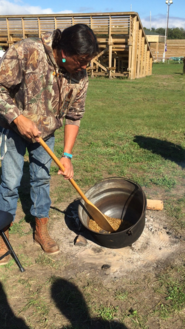
Autumn is a time to reflect on all that we have to be thankful for, as we enjoy
the harvest of nature’s bounty during gatherings with family and friends. In
Indian Country, culture and tradition are sustained through shared meals with
family and the community. Traditional foods are a powerful way for each new
generation to connect with and honor its history and its ancestors, and
participants in USDA’s Food
Distribution Program on Indian Reservations (FDPIR) have access to more
traditional foods than ever this year. November, Native American Heritage Month,
is an especially fitting time to celebrate the addition to FDPIR of bison, blue
cornmeal, wild rice, and wild salmon – foods that not only nourish a body but
sustain a culture. Read more
|
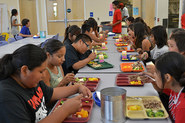
An ancient belief held by tribal communities is that the soil is cared for by
Mother Earth, the nurturer and the protector of the land. This idea
speaks to the importance of farm to school efforts in tribal communities. And
many tribal communities are reconnecting children with their rich history and
cultures by establishing farm to school programs.
Tribes are integrating traditional
foods into the Child
Nutrition Programs, sourcing foods locally, incorporating multicultural
nutrition education into classroom curriculum and providing hands-on lessons in
school gardens. USDA’s Office of Community Food
Systems supports tribal communities through the USDA Farm
to School Grant Program, assisting tribes across the nation to connect with
local producers and teaching children about where their food comes from. Read more
|
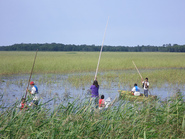
According to the 2012
Census of Agriculture, there were 71,947 American Indian or Alaska Native
farm operators in the United States in 2012, accounting for over $3.2 billion in
market value of agricultural products sold. Tribal Nations were identified as
one group that is an underserved segment of agriculture, and USDA Market
News is answering the call to provide them with the commodity data they
need.
USDA Market News – part of USDA’s Agricultural Marketing Service (AMS) –
assists the agricultural supply chain in adapting their production and marketing
strategies to meet changing consumer demands, marketing practices, and
technologies. USDA Market News reports give farmers, producers, and other
agricultural businesses the information they need to evaluate market conditions,
identify trends, make purchasing decisions, monitor price patterns, evaluate
transportation equipment needs, and accurately assess movement. Read more
|
Received
the Bold Leadership Award for Making His Warehouse Green
Sam Spang,
FDPIR Director of Sac and Fox Nation’s Food Distribution Program in Stillwater,
Oklahoma, has been recognized and honored
with the 2016 Bold Leadership Award. He has been working in partnership
with an electric service provider, Central Electric Cooperative and the company's Smart
Energy Solutions business unit, regarding 100 panel 28.5 kW Solar Array
(Net-metering/Grid-tied System) installation, a project that is being developed
for the SFN Food & Nutrition Center (Main Stroud Warehouse) for
installation in FY16.
Spang says, “Moving
forward with these latest developments, it is my goal to create increased
awareness for the significant need to support new projects that convert
innovative technology into operational growth and economic efficiency,
strengthening the financial performance and capabilities of our tribal
communities.”
Congratulation on your
award, and continued success with going green!
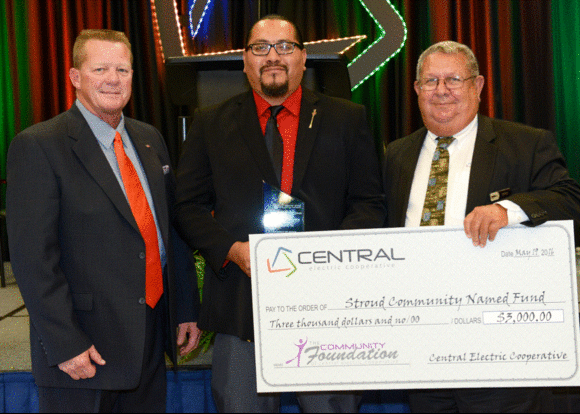
Security Update for eAuthentication
Several USDA web applications, including WBSCM and FFAVORS,
use eAuthentication
(eAuth) to manage login credentials. Users can recover a forgotten
password using a series of security questions established by the user. To address concerns about digital security
and privacy for its employees and customers, USDA has developed new security
questions that no longer use personally identifiable information (PII).
The new
security questions went into effect last month. If users haven’t already
done so, they will be prompted to select from the new non-PII security
questions and update their responses after the next successful eAuth logon.
All users are encouraged to pay attention to the responses provided
for the security questions. If an
external user forgets both the password AND the security question responses, they
will need to set up a new eAuth account and reestablish access to FFAVORS
and/or WBSCM with the new login ID. To
update the eAuth link for FFAVORS, contact the FFAVORS Help Desk. For WBSCM, contact the user administrator for
your organization.
If you have questions about these changes, please contact
the eAuth Help Desk.
The new aisles of Spirit Lake’s food distribution grocery store where USDA Foods are labeled in English and Dakota.
Crossing Devil’s
Lake: A Visit to Spirit Lake Sioux Tribe
The lake is long and expansive in nature. It sits
quietly even as its waves are in constant motion and hit along the banks of
Highway 57 in Fort Totten, North Dakota. The road that crosses the lake,
now elevated, still catches splashes of water, but securely leads you to Spirit
Lake Sioux Tribe Indian Reservation. Eagles fly above. Buffalo roam
below. And in between, among vast land and an enrolled membership of over
7,000 tribal members, the Food Distribution Program on Indian Reservations
(FDPIR) opens its new doors every weekday to over 750 participants on a monthly
average.
In 2016, Spirit Lake’s food distribution program, under the
direction of Mary Greene-Trottier, found a new home on the reservation in the facility
that previously housed the Dakotah Tribal Industries,
a tribal company that manufactured tents for the military under government
contracts. Retrofitted and reconfigured to fit the needs of the
program, the location off of Dakotah Drive now showcases a 4,800 square foot
grocery store, the first among food distribution programs in the Mountain
Plains region. Long aisles with tribal influences and glassed
refrigerators display the more than 100 USDA Foods products, labeled in English
and Dakota. Equally impressive as the store is the adjoining warehouse
space, high ceilings and neatly packed. Alongside the space is yet another
surprise that encompasses the nearly 19,200 square foot facility,
a staircase leading up to a room with a healthy vision.
Mary Greene-Trottier, the FDPIR program director since 1985, is continuing
to make improvements to the facility. The second floor will soon transform into a nutrition learning center. “Our goal is to have a
center where families, parents, youth, and elders can learn about nutrition
education, learn new skills, and enhance their cooking skills with a variety of
educational components such as gardening, food preservation, and recipe
demonstrations,” says Ms. Greene-Trottier. “We also plan to include a cultural
component with the classes. Individual cooking stations will also be
designed, giving the students a hands-on learning experience.” Spirit Lake’s
nutrition learning center is on schedule to host its first classes in 2017.
At the time of our visit in the
last days of November 2016, nutrition classes were in full force and offered throughout the
month with an onsite nutritionist as well as through a partnership with North
Dakota’s Cooperative Extension Program. Weekly classes target all age
groups. During our visit, small children learned how to make fruit
kabobs, high-schoolers received a lesson on nutrition education, adults
participated in a cooking demonstration, and counseling was provided to a
participant during a home-delivery visit – all in a day’s work!
Spirit Lake’s nutritionist teaching kids about the benefits of eating fruit while making fruit kabobs.
For the past two decades, the USDA has worked with the Department of Defense (DoD) to leverage its extensive procurement system to bring domestically grown fresh produce to ITOs. To help the nearly 95,000 FDPIR participants get access to fresh produce, the Defense Logistics Agency Troop Support’s Subsistence plays an important role. Since the Defense Logistics Agency (DLA) procures thousands of items to support the nation’s troops and military bases, using this network to supply FDPIR is mutually beneficial. Since 1995, DLA Troop Support has partnered with the USDA Food and Nutrition Service (FNS) to provide a consistent source of produce that may not be readily available in very rural areas. This program also offers a great opportunity to incorporate nutrition education into the participating household’s FDPIR experience. Many FDPIR program operators incorporate fresh produce into healthy messaging, provide taste tests, and conduct food demonstrations on ways to select, store, and cook nutritious meals using fresh produce provided by the program.
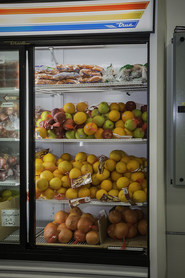
Through the USDA DoD Fresh Fruit and Vegetable Program, the USDA has been able to offer ITOs a larger variety of high quality produce, including pre-cuts, increased produce pack size, freshness, and consistent weekly deliveries above what would normally be available through USDA produce purchases. Additionally, the DoD is procuring locally grown produce to the greatest extent possible, consistent with season and quality.
For more about the FDPIR USDA DoD Fresh Program, check out the new Logistics on Location video titled “In Support of Native Americans: Western Washington State.” The video features two Food Distribution Programs, the Southern California Tribal Chairmen's Association and Small Tribes of Western Washington.
|
Feedback Reminder - USDA DoD Fresh and Other USDA Foods
For concerns regarding produce received through the USDA DoD Fresh Fruit and Vegetable Program, ITOs should contact their designated DLA service representative for direct customer service as well as the appropriate FNS Regional Office. If issues continue to be unresolved, please contact the USDA Complaints Team as noted below.
As a reminder, concerns or feedback related to other USDA Foods products should be submitted through the Web-Based Supply Chain Management System (WBSCM).
The USDA Foods Feedback and Complaint Team is available Monday-Friday, 6:00 a.m. – 5:00 p.m. Eastern Time. Email USDAFoodsComplaints@fns.usda.gov or call the USDA Foods Complaint Hotline at 800-446-6991.
USDA staff will be participating in these upcoming meetings in 2017. We look forward to the opportunity to meet you and hope to see you there!
March 27-30: FDPIR Training hosted by SouthWest Indian Food for Tribes (SWIFT) in Oklahoma City, Oklahoma
May 1-4: Western Region FDPIR Regional Conference (May 1-3) and 3rd Annual Nutrition Education Symposium (May 3-4) in Phoenix, Arizona
June
12-16: National Association of Food Distribution Programs on Indian Reservations (NAFDPIR) Annual Conference in St. Louis, Missouri

Here's how to sign up for these updates via GovDelivery:
1. Go to the Food Distribution website.
2. Click on the red envelope on the row of social media
icons on the top right of the page.
3. Enter your email address and click "Submit."
4. Check the boxes to select your topics of interest. For
these e-letters, scroll down to the Food Distribution category and click the
plus sign to the left of the check box to expand the list and view all the
sub-categories. Check these sub-categories to receive the corresponding
e-letters:
*USDA Foods --> receive all "USDA Foods from Farm
to Plate" general + program-specific e-letters
*Commodity Supplemental Food Program (CSFP) --> receive
"Household Highlights" e-letter
*The Emergency Food Assistance Program (TEFAP) --> receive
"Household Highlights" e-letter
*Food Distribution Program on Indian Reservations (FDPIR) -->
receive "FDPIR Connection" e-letter
*Schools/Child Nutrition Commodity Programs --> receive
"Spotlight on Schools" e-letter
5. Update your
subscription preferences any time by following the above steps or clicking on
the Subscriber Preferences Page link at the bottom
of any of the e-letter email messages you receive from
GovDelivery. Questions? Contact us at USDAFoods@fns.usda.gov
|
|